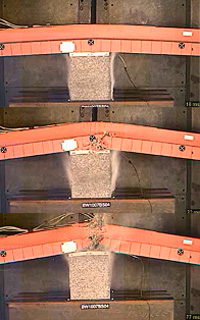Introduction
As terrorist attacks becomes more and more frequent all over the world these days - see 11 September 2001 - questions about the resistance of building and civil structures against assaults have been raised. One of the main targets of these attacks are buildings, with the aim to achiev a highest possible damage and a tragic loss of human lives. The “weapon” mainly used are cars or trucks which are either placed in front of the target building or ram into the building followed by an explosion. Hence, a possible scenario would cover blast induced shock waves, explosives in eventual combination of vehicle impact. This could in some cases even be followed by a huge fire. It is a fact that the currently used structures are not designed for such extraordinary “actions”. In the near future one has to think about the protection of buildings exposed to a high risk of terrorist attacks as e.g. military bases, embassies or places of religious gathering. Hence the market will ask for solutions in order to design structures in which people can live and work safely. Under such extreme loading situations, the survivability of a structure largely depends on the performance of key structural components and, in turn, on preventing progressive and total collapse. Clearly, for these accidental loading conditions, critical structural members are expected to undergo deformations beyond those tolerated under normal load combinations, but without experiencing local failure, and in a manner that enables load paths and redistributions to be mobilised within the structure even when considerable damage is sustained. Accordingly, appropriate assessment of the response of these key structural components is a primary consideration of the design process. Furthermore, whereas other loading conditions which may occur following impact and blast, such as ensuing fires, can be dealt with in a largely uncoupled manner, the post-impact/blast damage-state/residual-strength plays an important role and needs to be properly evaluated.
The main objective of the COSIMB project is the developement of arational and economical design concepts for composite members subjected to extreme actions such as blast or impact and ensuing fire. The composite members targeted here are columns and column wall systems as key elements of buildings and structures, which are supposed to sustain certain damage and deformation through extreme actions but still support at least gravity loads preventing non-proportional and progressive collapse. The work on impact and blast resistance of composite columns and column-wall systems involves static and dynamic tests (blast and impact) on a number of configurations, in addition to analytical and design studies.
Procedure and Results
The experimental inelastic behaviour of partially encased and of in-filled composite steel/concrete columns was examined. The test were carried out under idealised conditions representing extreme lateral laoding, with or without co-existing axial loads representing gravity conditions. The test results provide data for the validation and calibration of analytical and design studies. The inelastic response of composite columns and column-wall systems subjected to impact and blast loads was experimentally examined. Even impact or blast actions induced some local damage to the concrete parts of the members, especially the concrete column wall systems, the overall response and especially the remarkable residual strength demonstrates the very good qualification of the here examined high performance composite members for effective passive protection against impact or blast actions. Full fledged static and dynamic transient FE-simulations were carried out to simulate the tests and augment the understanding of the performance of composite members subjected to dynamic loading. The simulations of the impact and blasts tests was in very good agreement with the test results for the composite columns.
Summary and Outlook
With the developed design concept it is not only possible to design a key element, e.g. a perimeter column for specific local-resistance according to a given hazard scenario with the necessary strength. Moreover, allowable member rotation and deflection including damage and stiffness degradation may be evaluated leading possibly to a reduced level of residual strength but not the complete loss of that element. this opens the door for an improved design concept combining Alternate-Load-Path Method and Specific Local-Resistance Method to a Residual Strength Method.
Project partners
HOCHTIEF Construction AG, Frankfurt/Main
ArcelorMittal Belval & Differdange
Imperial College London
RWTH Aachen


